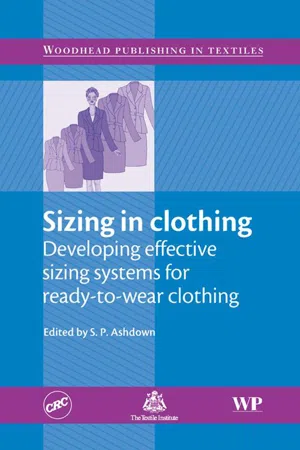
Sizing in Clothing
S Ashdown
- 408 pages
- English
- ePUB (mobile friendly)
- Available on iOS & Android
Sizing in Clothing
S Ashdown
About This Book
The basic concepts behind sizing systems currently used in the manufacture of ready-to-wear garments were originally developed in the 19th century. These systems are frequently based on outdated anthropometric data, they lack standard labelling, and they generally do not accommodate the wide variations of body sizes and proportions that exist in the population. However, major technological improvements have made new population data available worldwide, with the potential to affect the future of sizing in many ways. New developments in computer-aided design and sophisticated mathematical and statistical methods of categorizing different body shapes can also contribute to the development of more effective sizing systems. This important book provides a critical appreciation of the key technological and scientific developments in sizing and their application.The first chapter in the book discusses the history of sizing systems and how this has affected the mass production of ready-to-wear clothing. Chapters two and three review methods for constructing new and adapting existing sizing systems, and the standardisation of national and international sizing systems. Marketing and fit models are reviewed in chapter four whilst chapter five presents an analysis of the grading process used to create size sets. Chapters six and seven discuss fit and sizing strategies in relation to function, and the communication of sizing. Mass customization and a discussion of material properties and their affect on sizing are addressed in chapters eight and nine. Military sizing and the aesthetics of sizing are detailed in chapters ten and eleven. The final chapter reviews the impact on sizing of production systems and specifications.Written by an international team of contributors, this book is an essential reference to researchers, designers, students and manufacturers in the clothing and fashion industry.
- Provides a critical appreciation of key technological and scientific developments in sizing and their application
- Discusses how developments in sizing affect the mass production of ready to wear clothing
- Reviews methods of constructing new and adapting existing sizing systems
Frequently asked questions
Information
History of sizing systems and ready-to-wear garments
1.1 Introduction
1.2 The emergence of sizing systems
1.2.1 Clothing construction before the nineteenth century
Table of contents
- Cover image
- Title page
- Table of Contents
- Copyright page
- Contributor contact details
- Preface
- Dedication
- 1: History of sizing systems and ready-to-wear garments
- 2: Creating sizing systems
- 3: Sizing standardization
- 4: Sizing systems, fit models and target markets
- 5: Pattern grading
- 6: Function, fit and sizing
- 7: Communication of sizing and fit
- 8: Mass customization and sizing
- 9: Materials and sizing
- 10: Sizing for the military
- 11: Sizing and clothing aesthetics
- 12: Sizing for the home sewing industry
- 13: Production systems, garment specification and sizing
- Index